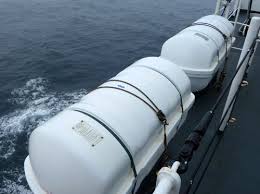Blog Post
Step-by-Step Guide to Launching Liferaft in Emergency Situations
Posted By: Harsh Bamnolia
Posted On : 30-May-2025

Step-by-Step Guide to Launching Liferaft in Emergency Situations
Launching Liferaft: Why It Matters in Maritime Emergencies
Launching liferaft procedures are vital components of a vessel's emergency preparedness strategy. The ability to effectively deploy a liferaft can mean the difference between survival and catastrophe in critical moments at sea.
Liferafts provide immediate buoyancy, shelter, and supplies to help crew and passengers stay afloat and alive until rescue arrives.
According to SOLAS (Safety of Life at Sea) regulations, knowing the proper method for launching liferaft is not only mandatory but can also significantly reduce panic and increase survival rates during maritime disasters.
Modern liferafts are engineered for rapid deployment and are designed to work in conjunction with hydrostatic release mechanisms or manual launching systems.
This guide outlines every step involved in launching liferaft during emergencies, along with best practices and safety tips.
Key Preparations Before Launching Liferaft
Before an emergency ever arises, certain preparations are essential to ensure smooth and effective launching liferaft operations. These include:
1. Familiarity with Liferaft Types and Location
Ensure the crew knows the exact location of all liferafts on board.
Understand the type of liferaft installed—whether it's davit-launched, throw-overboard, or self-inflating.
2. Routine Inspection and Servicing
Liferafts must be inspected annually by authorized service providers like Marinetech.
Check for expiry dates, pressure conditions, and the integrity of the container.
Ensure the hydrostatic release unit (HRU) is properly installed and not expired.
3. Crew Training and Drills
Conduct regular training sessions on launching liferaft protocols.
Practice abandon ship drills to ensure readiness and familiarity with equipment.
Launching Liferaft: Step-by-Step Process
When faced with an emergency such as fire, flooding, or sinking, the launching liferaft procedure must be executed calmly but swiftly. Here is a comprehensive breakdown:
Step 1: Assess the Situation
Determine if the liferaft deployment is necessary and safe.
Avoid launching on the side facing rough seas or fire.
Step 2: Position the Liferaft
For throw-overboard liferafts, bring the container to the ship's side.
Ensure the painter line is securely tied to a strong point on the vessel.
Step 3: Deploy the Liferaft
Throw the container overboard.
The liferaft will float on water due to its buoyant design.
Step 4: Inflate the Liferaft
Pull the painter line forcefully to activate the CO2 cylinder inside.
The raft should inflate in 20-30 seconds.
Step 5: Board the Liferaft
Lower injured or elderly individuals first.
Use ladders, life lines, or embarkation platforms.
Avoid jumping directly into the raft to prevent damage.
Step 6: Cut the Painter Line
Once everyone is safely aboard, use the liferaft knife to cut the painter line.
Paddle away from the vessel to avoid being dragged down if it sinks.
Safety Measures During Launching Liferaft
Use of Personal Protective Equipment (PPE)
Ensure all evacuees are wearing life jackets.
Carry EEBDs (Emergency Escape Breathing Devices) in smoke-filled conditions.
Emergency Pack Check
Verify that the emergency pack inside the raft contains water, rations, flares, sea anchor, thermal protective aids, and first-aid supplies.
SOLAS liferafts are equipped with either a SOLAS A or B pack depending on voyage length.
Communication and Signaling
Use handheld VHF radios, EPIRBs (Emergency Position Indicating Radio Beacons), or SARTs (Search and Rescue Transponders) if available.
Signal your location using handheld flares or mirror reflectors.
Maintenance and Servicing of Liferaft Equipment
Ensuring the proper functioning of all components used in launching liferaft is critical. Marinetech Safety & Shipping Corporation offers end-to-end servicing solutions compliant with SOLAS and IMO standards. Services include:
Annual Liferaft Inspection & Certification: Approved by classification societies.
Hydrostatic Release Unit Testing and Replacement
Leak Test and Repackaging of the liferaft container
Emergency Pack Restocking based on SOLAS guidelines
With their experienced technicians and shore-based servicing stations, Marinetech guarantees that your life-saving equipment is always in operational readiness.
Conclusion: Be Prepared, Stay Safe
Launching liferaft during emergencies is a skill that requires preparation, precision, and presence of mind. The steps involved are simple yet crucial—each designed to secure the safety of those on board in distress situations.
By understanding the process, ensuring proper maintenance, and choosing certified providers like Marinetech, vessels can stay compliant and more importantly, be ready for the unexpected.
To schedule a certified inspection or learn more about our liferaft servicing capabilities, visit Marinetech Liferaft Services.